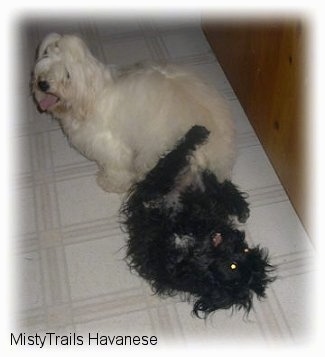Just like people, dogs slow down as they grow older. Their hair turns gray, their eyes dim, their bodies lose tone and energy. They become more susceptible to illness, less adaptable to change and even forgetful as time marches on. They look to you for help and comfort.
When Is Your Dog "Old"?
The old rule-of-thumb that one dog year equals 7 years of a human life is not exact. The ratio is higher with youth and decreases a bit as your dog ages. Depending on the breed, a dog experiences the raging hormones of adolescence anywhere from 8 months to 2 years or more. Generally, a dog of 6 has aged about as much as a 45-year-old human. At 10, she's like a human of 65; at 12, a human of 75; and at 15, a human of 90.
You are the best judge of your dog's stage of life. Even if she is in the best of health, it's important that you notice when your dog begins to show her age. After years of constant companionship, however, you may not see the first subtle signs of decline. No matter how close you are, your dog does not know how to communicate little aches and pains, and even some bigger discomforts to you. She doesn't understand what's happening to her when she can't run as fast or jump as high.
When to Screen for Aging
Most veterinarians recommend that your dog be screened for the symptoms of aging and then come for twice-yearly visits when she is a senior. To determine when it's time for the first screening, you have to understand how your dog's medical history and breed might hasten or stave off her senior symptoms. Then, factor in these recommendations:
For dogs over 80 pounds, begin geriatric screening between ages 4 and 6.
For dogs 51 to 80 pounds, begin to screen between 6 and 8.
For dogs 16 to 50 pounds, begin to screen between 7 and 9.
For dogs 15 pounds or less, begin to screen between 9 and 11.
Since the 1930s, the canine life span has increased more than 70 percent, from seven years to 12! And that's just the average. With advances in veterinary care and nutrition and more knowledgeable owners, many good-sized dogs now live to 14.
Of course, no one can really predict how long an individual dog will live. There's always the possibility of unpredictable illness or accident. Or, a genetic predisposition to disease may lurk in your dog's genes. But generally speaking, the larger the breed, the faster it ages.
Giant breeds - even pampered and exercised St. Bernards - can begin to show their years as early as four and have a life expectancy of 7 to 11 years. The chihuahua is the smallest breed, with adults weighing between 2 and 9 pounds. They can live 18 years or more. Certain breeds do better than others, as do mixed breeds. On average, smaller mutts and mutts with dominant genes from smaller breeds live longest.
Vets can't yet explain why length of life varies so much with size. "We think of large dogs as having a different metabolism, as living their allotted time faster than smaller dogs," says Dr. Harold Zweighaft of New York City.
Life Spans By Breed
The following list of predicted life spans shows how long various breeds may live.
7-10 years. Great Dane, Newfoundland, Cavalier King Charles spaniel. (Mitral valve disease may affect 50 percent of these toy spaniels in North America.)
9-11 years. St. Bernard, bloodhound, chow chow, boxer, French bulldog. (Von Willebrand's disease, akin to human hemophilia, can impede blood clotting in Frenchies.)
10-13 years. Airedale terrier, Dalmatian, golden retriever, German shepherd, Scottish terrier. (Scotties also may inherit von Willebrand's.)
12-15 years. Beagle, bichon frise, collie, Doberman, papillon, Pomeranian.
14-16 years. Boston terrier, cairn terrier, cocker spaniel, Welsh corgi, Irish setter, Parson Russell terrier, Maltese terrier, poodle (standard), schnauzer, shih tzu, West Highland White terrier, Yorkshire terrier.
15-18 years. Dachshund, poodle (miniature and toy), Chihuahua.
It's up to you to maintain your dog's health and sense of security and to make sure that she's able to enjoy her natural athletic ability as long as possible. You must be perceptive, noticing changes in your dog's moods and habits. It takes love and commitment to help your dog navigate old age, but it will be returned in kind.






